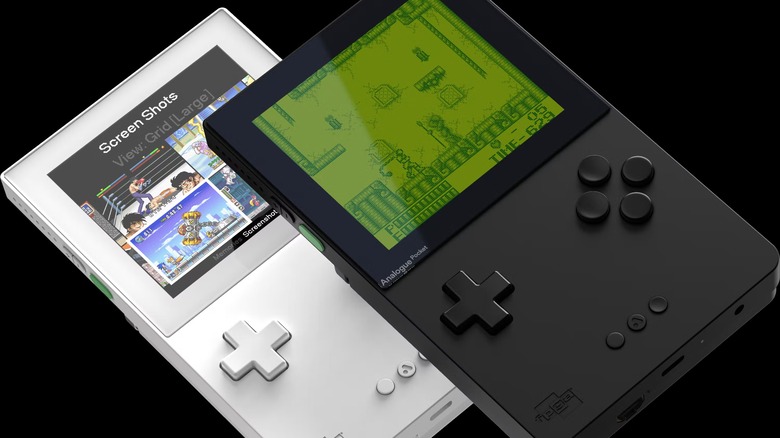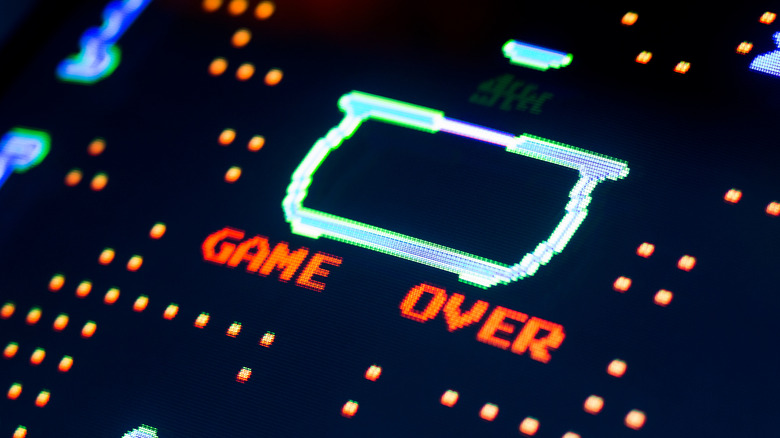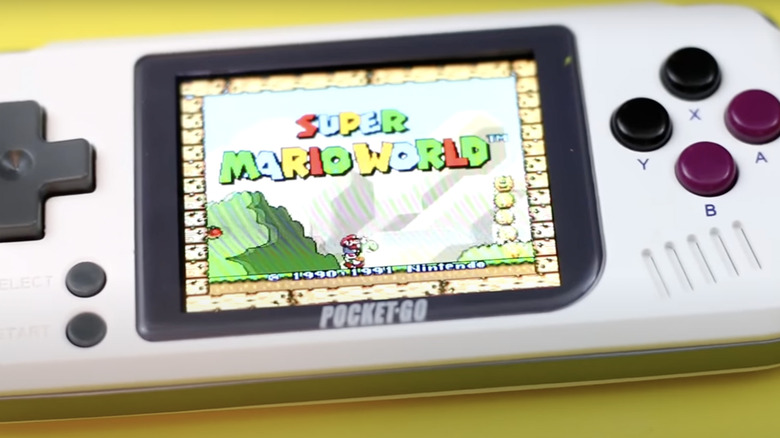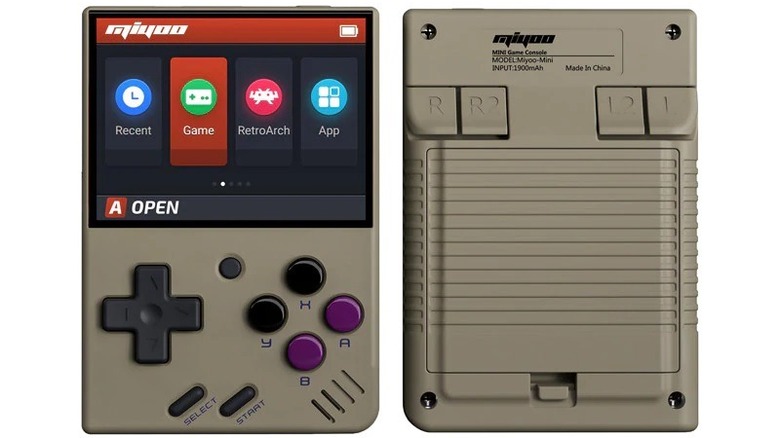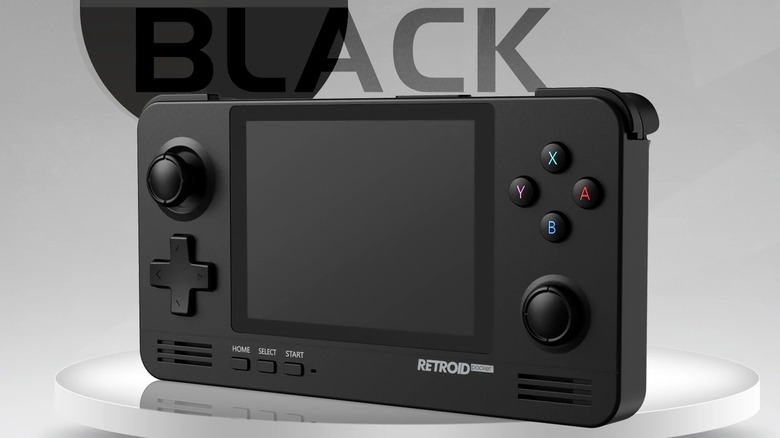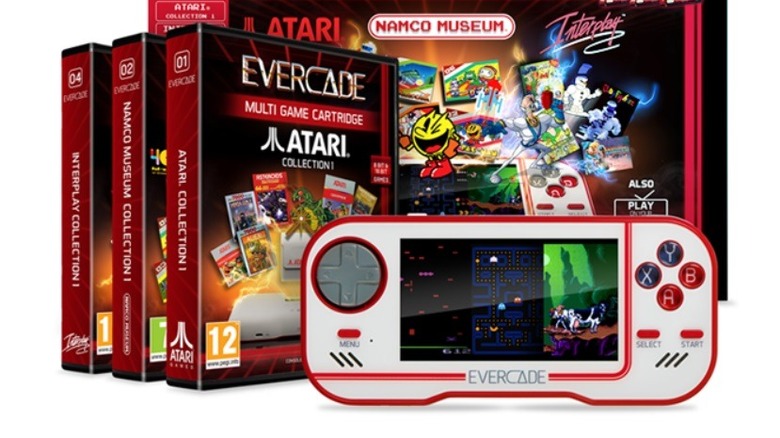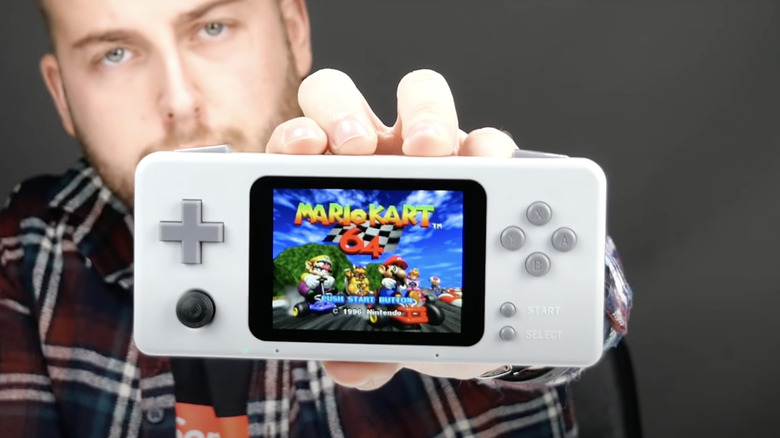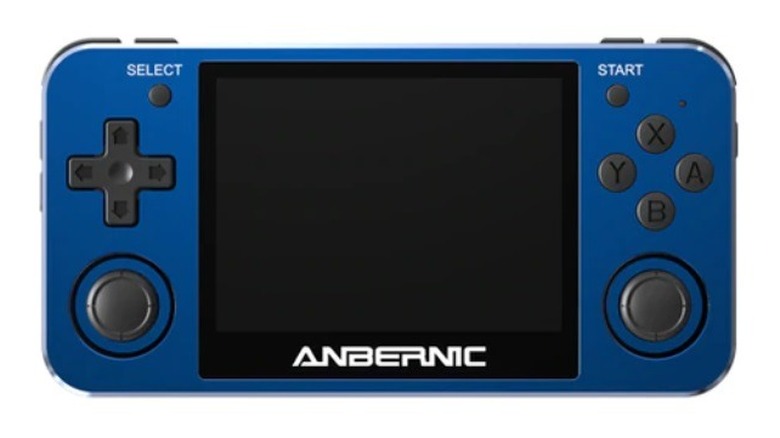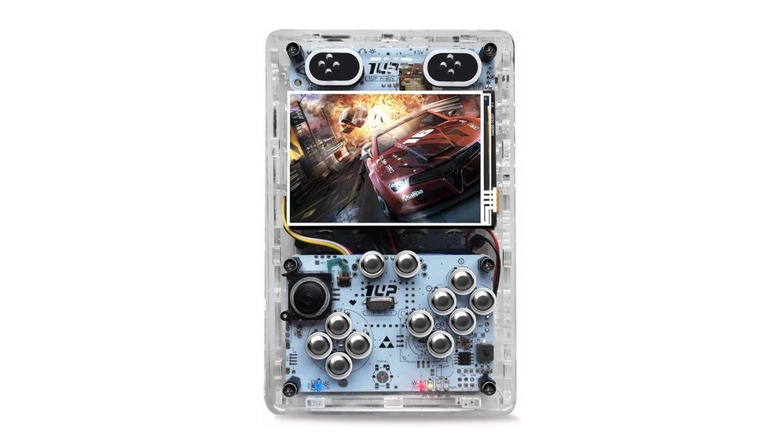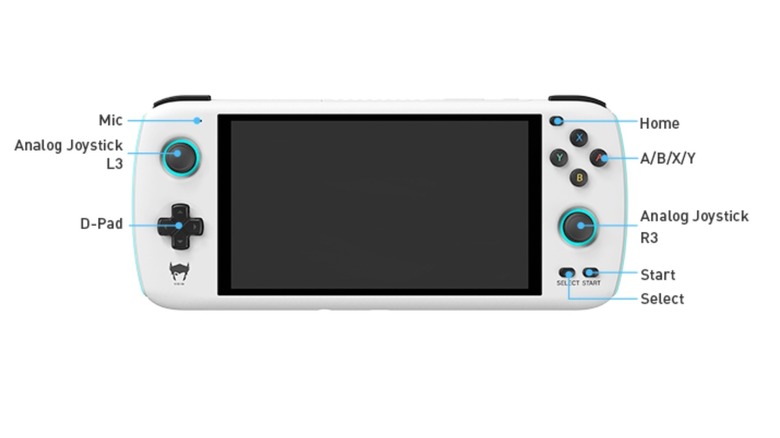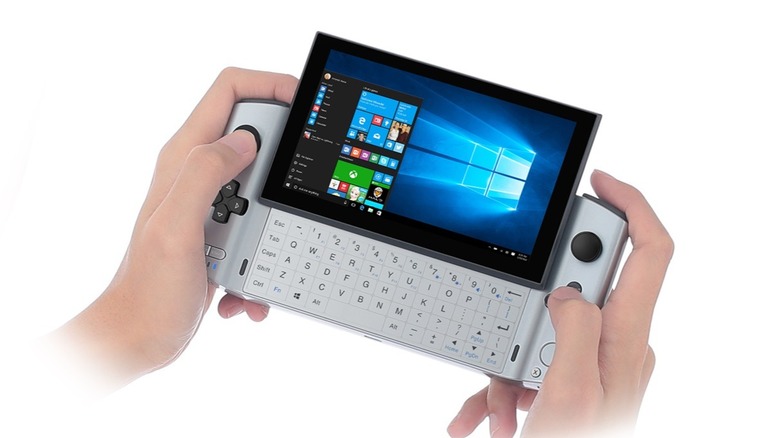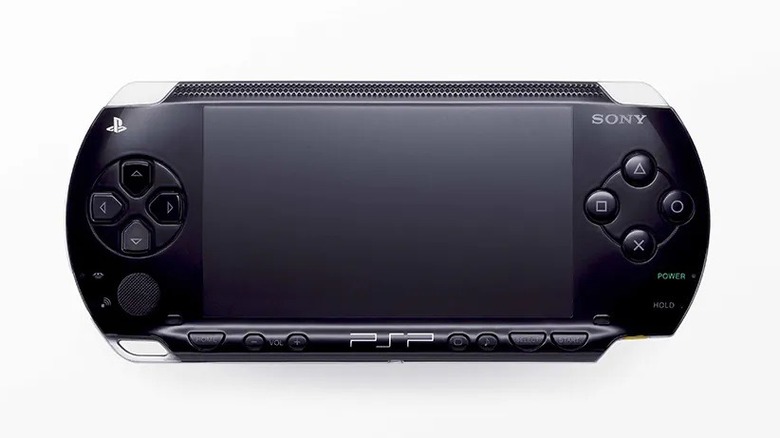Analogue Pocket Alternatives That Will Give You A Great Retro Gaming Experience
The Analogue Pocket was announced October 16, 2019, to high fanfare among retro gaming enthusiasts. The Pocket sets a high bar for handheld retro gameplay, offering a device that looks enough like the original Game Boy to inspire nostalgia while packaging itself in high quality materials and specs. The Pocket has some other functionalities related to audio production utilizing a built-in synthesizer, but the retro gameplay is what we really care about. In that regard, the Pocket is no slouch.
It's compatible with roughly 3,000 retro games including those from various iterations of the Game Boy and the Sega Game Gear, Neo Geo, and Atari using cartridge adapters. If you're looking for a retro gamer the Pocket is one of the best, but it does have downsides. First, at the time of this writing the wait times to get your hands on one stretch into 2023, and it doesn't emulate, so you'll have to own physical copies of any games you want to play.
Luckily, if you want to get into retro gaming without breaking out your old NES, there are alternatives. Analogue isn't the only player in the retro gaming space and there are more than enough options to scratch your retro gaming itch while you wait for your Pocket to ship.
Are emulators and ROMs even legal?
Before we jump into the world of retro gaming devices we need to talk about emulators and ROMs. While some of the devices on our list do play cartridges, they are the exception not the rule. Most of the gadgets you're likely to find online emulate classic systems and play ROMs.
Since you're reading Slashgear you're probably familiar with what those are but, briefly, emulators are software which run a digital version of the hardware in classic consoles. Because computing technology has improved vastly since the '70s and '80s, you can fit a lot of them in a small package. ROMs are essentially rips of a game's code which you can play on an emulator.
From a legal standpoint, there's no risk in downloading emulators (per Retro Dodo), but the use of ROMs gets a little fuzzier. The creation of a ROM as a backup for a game you physically own is probably legal, uploading it to the internet is not. Downloading or purchasing a ROM of a game you physically own is maybe legal and downloading ROMs of games you don't own probably isn't.
There isn't actually any precedent in case law regarding video games ROMs (per How-to Geek) so a lot about legality one way or another is speculation based on similar mediums. Ultimately, the download and possession of ROMs is a legal gray area and Slashgear doesn't suggest or condone the performance of any illegal activity. Proceed with caution.
The PocketGo
The PocketGo is one of several pocket retro gaming devices made and sold by BittBoy. It's a little smaller than we'd like for a handheld, which could become a bit of a problem if you intend to play for extended periods, but that's just about the only problem with it.
The PocketGo comes stocked with an array of emulators capable of playing your favorite games from the NES, SNES, Sega Genesis, all the way up through the PlayStation 1. It doesn't come with any games preinstalled. Loading ROMs onto the device via the included SD card is the responsibility of the user (per The Gamer).
The included headphone jack allows for silent gaming while in public and it includes a volume wheel, something some of the other devices on this list are lacking. The 2.4-inch screen is covered in tempered glass and backlist, offering full color gaming without the need for any external light source. Overall, it's a solid machine for playing old games, especially considering it only costs $39.99.
If you're looking to get into retro gaming handhelds without breaking the bank, it's tough to do better than the PocketGo.
Miyoo Mini
The Miyoo Mini is another pocket-sized retro gamer from the folks at BittBoy. Instead of the landscape design of the PocketGo, this one's shell more closely resembles the original Game Boy. In fact, it could almost pass for a Game Boy at a glance if not for the comparatively massive 2.18-inch LCD display which takes up almost every millimeter of real estate on the Mini's top half.
The button layout is intuitive, mirroring what you'd find on a Game Boy, with the notable addition of triggers on the back of the device. Those triggers aren't absolutely necessary if you're sticking to the older retro games, but they become important as you move toward the modern day.
To that end, the Miyoo Mini comes loaded with 13 emulators running basically everything up through the PS1. There are some performance issues when running hungrier titles or emulators (per Obscure Handhelds) and the audio and video aren't perfect, though some might say that adds to its retro charm, and you can get around some of those misgivings by using headphones.
All things considered, for $59.99, it's a solid machine which does the job it was designed to do.
Retroid Pocket 2+
The Retroid Pocket 2+ is the latest retro gamer from Go Retroid and builds on the success of the original Retroid Pocket 2. Unlike some of the other devices on this list, the Pocket 2+ is brand spanking new and are currently still running on a pre-order system, though their website indicates they are currently delivering previous orders and yours should ship about 35 calendar days after the order is places.
The shell design is similar to what you'll find on a Nintendo Switch with the exception of harder edges and its internal system uses Android 9 to run a whole host of emulators including the usual suspects from the early days of gaming up through PS1. It can ostensibly run PSP, Dreamcast, and PS2 games but that runs up against the limits of its abilities and you're likely to have problems playing games from those systems (per Retro Dodo).
Those constraints aside, the Pocket 2+ is a top-tier gaming device for what it's designed to do. It's 3.5-inch 480p screen is more than adequate for old school gaming and it's got a host of extra features including rumble motors, WiFi and a mini-HDMI out, which allows you to display your games on a larger screen.
For $99.99 you'll get 32GB of internal storage and a choice of black, white, blue, or yellow shell.
Evercade
The Evercade has one of the coolest designs out of any device on this lit. It's off-white shell with red trim looks like something straight out of "The Last Starfighter" which helps to sell the retro feel. It also offers one of the largest screens of any retro gaming machine at 4.5 inches, although most games play on a 4:3 aspect ratio meaning you're left with some black bars of unused screen.
As explained by IGN the Evercade comes with an micro HDMI out port, letting you move your games to a bigger screen and 4.5 hours of battery life is more than enough for most casual gamers. Unlike most of the devices on this list it doesn't use emulators and ROMs. Instead, there are a series of cartridges which each come with a collection of old school games. That does mean there's continued cost to grow your collection but the system itself is only about $100.00 and each game pack comes in around $25.00 to $30.00. Considering the cost of most modern games and systems, it's a reasonable investment.
The other major downside is that the selection of games is less robust than you might find by searching for game ROMs on the internet. The tradeoff, however, is the enjoyable tactile sensation of clicking in a cartridge and the comfort of knowing you won't run afoul of the law.
Hyperkin SupaBoy
There's a lot to love about this Super Nintendo clone, not the least of which is it's $100.00 price point and nostalgia-heavy design.
Right off the bat, the SupaBoy looks great. One glance at it and you know exactly what it's supposed to be. The shell looks like a bloated Super Nintendo controller, colored teal or black, with a screen slotted into its center. Its design makes it a little too bulky to slide into a pocket, unless you have unusually large pockets, but it's still portable enough to be carted around.
Instead of emulators, the SupaBoy takes the place of your old SNES with a cartridge port mounted at its top. With a cartridge added in, it does become a little unwieldy as a handheld but the button layout his strategic enough that the cartridge doesn't get in the way of gameplay. Moreover, the SupaBoy comes with two SNES controller ports in the front, allowing you to prop it on a table and play at a distance. That also means multiplayer is as easy as clicking in a second controller.
Despite being a relatively recent device, the SupaBoy does not have an HDMI out, instead opting for an AV port, which means it is capable of displaying on your TV but the picture quality isn't as good as it could be (per Nintendo Life). Still, it's a perfectly serviceable replacement for the Super Nintendo your mom sold at a garage sale while you were away at college.
Retro CM3
The Retro CM3 may not look like much and you'd be forgiven for balking at its $150.00 price point but it packs a lot of punch. The shell, especially the standard gray, looks like it's about two steps up from something your neighbor might have 3D printed in their garage, but that can be remedied somewhat with any of the alternative shells. Options include black with red or blue buttons or various semi-transparent shells. The button layout is simple, including just ABXY, start, select, a D-pad, one analog stick, and a couple of triggers at the top.
Where the Retro CM3 really shines is on the inside. It uses a Raspberry Pi CM3 Lite board and comes stocked with 45 emulators and thousands of games preinstalled. There's also a slot for an SD card which leaves open the option to add any additional emulators or ROMs you might like.
The Raspberry Pi is fully capable of running games up to N64 and PS1 (per Retro Dodo). So, if you can get over the middling build quality of the exterior, you're in for an enjoyable gaming experience.
The Retro CM3 doesn't have the option to play multiplayer or connect to a television but its size does make it perfect for carrying in a pocket, and six hours of playable battery life will keep you gaming on the go.
RG351mp
The RG351mp from Ambernic is one of the best-looking handhelds on our list, owing to its well-manufactured metal shell. While some other retro gamers look and feel cheap, even if they perform well, the RG351mp is robust enough to withstand normal wear and tear, and you'll be proud to cart it around. Getting into one will run you $159.99.
The button layout is intuitive and includes two analog sticks and four bumper buttons, in addition to the usual ABXY and D-pad. It boasts a 3.5-inch display at a ratio of 4:3, 1GB of ram and 125GB of internal storage. All of that might not sound very impressive when comparing to modern computers or gaming systems but it's more than enough to play your favorite retro games.
The RG351mp is an emulator-based system which uses Android as its foundation. It's compatible with most of the retro systems you've come to expect by this point. It runs the classic Atari, Nintendo, and Sega games without a hitch and even does well with PS1 games, but does have some trouble with the N64, PSP, and a few others (per Retro Handhelds).
It offers two SD card slots on the bottom, though you'll only need one to play. Its onboard lithium ion battery offers 8 hours of battery life under ideal conditions and an included WiFi dongle allows you to grab files from the internet without having to move SD cards to a computer.
Gameboy 1UP XL
The Gameboy 1UP XL looks like what you might get if you gave a nine-year-old in the '90s the keys to Nintendo's workshop and the authority to build their dream Game Boy. The overall design is familiar, but the edges have been squared off, the shell is fully transparent, giving you a view to all of its guts, and every button — with the exception of the analog stick — has been replaced with unlabeled chrome. If you can get past the unusual design, it offers one of the best collections of features we've seen in a handheld.
It uses A Raspberry Pi3 Model B to run emulators up through the PS1 and comes with more than 10,000 games preloaded on the system, allowing you to start playing the moment you pull it out of the box.
Its 3.5-inch screen displays HD video at 60 frames per second, which is probably overkill for playing Mario, but we won't balk at it. As explained by Retro Dodo, there are four USB ports on the side for adding external controllers and an HDMI port for displaying on your television. It's almost the retro equivalent of a Nintendo Switch in its ability to easily transform from an on-the-go handheld device to a complete at-home system.
Costs run between $189.99 and $229.99, depending on the amount of SD storage you select.
AYN Odin
The AYN Odin is in the top tier of retro gamers, both in terms of price and functionality. Odin essentially took an Android phone and built a gaming control box, resembling the Nintendo Switch Lite around it. For their initial production run, the company ran a successful Indiegogo campaign raising more than $4 million to date. The project has begun shipping its initial runs but, at the time of this writing, you can still order through the campaign page at the discounted backer rate.
To use your Odin, you'll log into your Google account and download emulators, then install ROMs using an external SD card (per Retro Dodo). The six-inch touch screen allows for easy menu navigation and it's capable of running the usual slate of retro games.
Further building on the Nintendo Switch model, Odin also offers a Super Dock as an additional accessory which allows you to connect the device to a television and also adds the ability to use N64 and Gamecube controllers (per TechRadar).
There are three models available, including the Lite, Base, and Pro and getting your hands on one will cost between $198.00 and $358.00 depending on which model you choose. Of course, that's before any additional accessories like the Super Dock.
GPD WIN 3 Mini Laptop
The GPD WIN 3 is on a whole other level from every other device we've included on this list, but if you're looking for a stellar handheld gaming experience and price isn't an obstacle, you might not be able to do any better.
We're not talking about a system that clones old gaming consoles and runs ROMs, though it most certainly could do that. This toy is essentially a full-fledged gaming computer shrunk to a size that will fit in your hands. It comes equipped with a terabyte of internal storage and 16GB of ram. Its internal specs are good enough to run modern PC games in addition to the retro games of your youth.
If retro gaming devices are still being sold at secondhand shops in 30 years, this is the device every cyborg kid will be looking for. It has the usual button layout you're used to, and the screen slides up to reveal a full keyboard for typing (per Robots.net).
The only real problem here is it's going to cost you roughly $1,300.00. This gaming PC has been shrunk into a handheld shell but the price, unfortunately, remains very large.
Make your own
You've probably noticed that the majority of the devices on our list run using either Android or Raspberry Pi technologies. Those are devices which are easily available, affordable, and moderately simple to transform into the retro gaming machine of your dreams.
A decent Raspberry Pi board or a secondhand Android phone with a gaming controller, and the willingness to read through a tutorial or two will get you to a workable device with a minimum of fuss. In fact, if you have an Android phone you're no longer using, a USB HDMI adapter, a USB controller, a charging cable, and a connection to the internet, you already have everything you need to start playing retro games right now (per Make Use Of).
Alternatively, if you have an old PSP lying around, or a secondhand game shop where you could find one, they make a perfect solution for emulating classic games. Emulators intended for use on the PSP exist online and there are tutorials to walk you through each step in transforming your antiquated gaming technology into an even more antiquated gaming system, with the benefit of maintaining a high-quality shell which was designed for handheld gaming.
The good news is, there are plenty of options for getting your hands on some good old-fashioned nostalgia while you wait for your Analogue Pocket order to ship.
